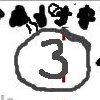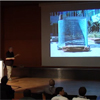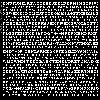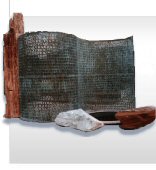sotpyrk/canyouseeanything

Kryptos Reproduction
Price: $150.00
Product Facts: When these words appeared hidden on the dust jacket of
Dan Brown's The Da Vinci Code, speculation to their meaning led people
to a place few would dare to tread, CIA headquarters. In 1990, then director
William Webster (WW) commissioned new artwork to beautify the grounds of the
CIA headquarters in Langley, Virginia. Called Kryptos after the Greek word
for "hidden," the theme of his sculpture is "intelligence gathering."
Working with then Chairman of the CIA Cryptographic Center Ed Scheidt, the artist
created cryptographic systems in the sculpture that no one has yet been able
to completely break. Of the four panles, the now infamous last panel, remains
unbroken.
Located in the northwest corner of the New Headquarters Building courtyard, the main sculpture resembles a screen divided into four parts and covered in encrypted text. This replica is an accurate scale model of the original main sculpture.Now you can match wits with the legions of code-breakers who have thus failed to crack all four panels. Best part is you don't need a security clearance to get near it.
Not Available for International Shipping
|
Technical Data: 6x10. Made of nickel silver which darkens naturally with age.
Compiled from Zola International Spy Museum
|
|

|
 | The International Spy Museum is a privately owned museum dedicated to the field of espionage located in the Penn Quarter neighborhood of Washington, D.C., across the street from the Old Patent Office Building (which houses the Smithsonian American Art Museum and the National Portrait Gallery) and one block south of the Gallery Place-Chinatown Metro station.
The museum was built by The Malrite Company at a cost of US$40 million. Despite being one of the few museums in Washington that charges admission fees, it has been immensely popular since its opening in July 2002.
|
 |

My niece and I in front of the Spy Cafe right next door.
All three (the SPY Cafe, Museum, and the Restraunt) take up the whole block |
The over 600 artifacts in over 20,000 square feet (1900 m²) of exhibition space[3] relate the history of espionage and spies in real-world practice and in popular culture. The museum has extensive exhibits on espionage methods and materials dating from the Greek and Roman empires, the British empire, the American Revolutionary War, the American Civil War, the World Wars, and the Cold War years.
Most of the exhibit areas bring visitors into the era's espionage environment. Numerous visitor-interactive stations are located throughout the exhibit areas. At the terminus of the exhibit area an 8-minute feature film updates and describes how modern technology has changed the face of warfare and terrorism.
| |
--Compiled from Wikipedia
|
|






 Hint: I used steganography to hide my X-files --- (login/username/passwd is on every page) Happy Hunting!!!!
Hint: I used steganography to hide my X-files --- (login/username/passwd is on every page) Happy Hunting!!!! 







